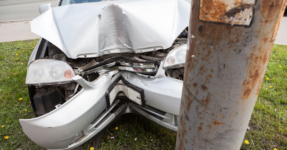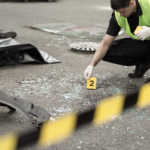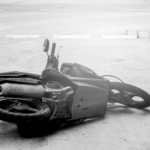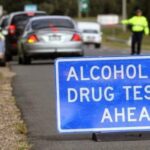Failing to Stop and Assist After an Impact Causing Injury, GBH or Death in NSW

A teenager has been charged with a string of driving offences following a car crash in Wollongong that police believe caused the death of a 12-year old boy.
According to police, the 17-year old male was driving a stolen Holden Barina north on Memorial Drive in Wollongong just after 1am on Tuesday, 4 October 2022 before the vehicle lost control at around 1.35pm and crashed into a power pole at the intersection of Towradgi Road in Towradgi, a small, beach-side suburb approximately 5 kilometres north of Wollongong.
Officers from Corrimal Police Station arrived at the scene but found the vehicle to be empty.
Just after 2am that morning, emergency services were called to a home in Balgownie, about 2.5 kilometres south-west of Towradgi, where it was reported a 12-year old boy with significant injuries had been dropped-off there in a silver car.
The boy was conveyed by ambulance to Wollongong Hospital where he was pronounced dead on arrival due to his injuries.
Police arrested the 17-year old boy three days later and charged him with dangerous driving occasioning death, negligent driving occasioning death, failing to stop and give assistance after impact causing grievous bodily harm, failing to stop and give assistance after impact causing death, causing injury by misconduct in charge of a vehicle and driving whilst unlicensed.
Police claim to have “established links” between the teen and the collision.
Possible TikTok link
Police say they are investigating whether the incident is part of the growing TikTok trend of young people filming themselves stealing cars and breaking into properties, and posting their crimes online.
They are appealing for witnesses or anyone with details about the stolen vehicle or the crash as their enquiries continue.
Failing to stop and assist after an impact causing injury or death in NSW
Failing to stop and render assistance after collision that causes an injury or death can amount to an offence under both the Crimes Act 1900 (NSW) and Road Transport Act 2013 (NSW).
Crimes Act 1900: Failing to stop and assist after impact causing death
Failing to stop and assist after vehicle impact causing death is an offence under section 52AB(1) of the Crimes Act 1900 which carries a maximum penalty of 10 years in prison.
To establish the offence, the prosecution must prove beyond reasonable doubt that:
- You drove or rode a vehicle,
- The vehicle was involved in an impact which occasioned the death of another person,
- You knew, or ought reasonably have known, that the vehicle you were driving or riding had been involved in an impact causing the death of, or grievous bodily harm to, another person,
- You failed to stop and give assistance that may have been necessary, and
- It was within your power to stop and give that assistance.
A ‘vehicle’ is defined as:
- Any motor car, motor carriage, motor cycle, or any other vehicle propelled, wholly or partly, by volatile spirit, steam, gas, oil, electricity, or by any other means other than human or animal power, or
- A horse-drawn vehicle.
The definition includes any such vehicle, whether or not it is adapted for road use, but does not include a vehicle used on a railway or tramway.
An ‘impact’ is that which occurs:
- Between an object or a person and the vehicle,
- Between an object, including the ground, due to being thrown from the vehicle,
- With another vehicle or object in, on or near a person,
- With anything on or attached to the vehicle, or
- With anything in motion through falling from the vehicle.
Crimes Act 1900: Failing to stop and assist after impact causing grievous bodily harm
Failing to stop and assist after vehicle impact causing grievous bodily harm is an offence under section 52AB(2) of the Crimes Act 1900 which carries a maximum penalty of 7 years in prison.
The ‘essential elements’ (ingredients) the prosecution is required to prove are the same as for the preceding subsections except, of course, for the fact that grievous bodily harm is occasioned, rather than death.
The definitions of ‘vehicle’ and ‘impact’ are also the same.
What is grievous bodily harm?
Section 4 of the Crimes Act 1900 makes clear that grievous bodily harm includes, but is not limited to:
1. The destruction of the foetus of a pregnant woman, whether or not the woman suffers any other harm, other than in the course of a medical procedure or a termination of a pregnancy in accordance with the Abortion Law Reform Act 2019,
2. Any permanent or serious disfiguring of the person, or
3. Any grievous bodily disease.
New South Wales case law explains that grievous bodily harm should be considered in plain terms as any form of ‘really serious harm’; DPP v Smith [1961] AC 290; Haoui v R (2008) 188 A Crim R 331. So, there is no exhaustive list of what may or may not amount to such harm.
However, the following types of injuries have been considered as sufficient by the courts to amount to grievous bodily harm:
- A fractured arm,
- ‘Glassing’ of the face requiring stitches,
- A gaping wound to face and throat requiring large number of stitches, and
- Severe facial and/or cranial injuries.
Road Transport Act 2013
Failing to stop after impact causing injury or death is an offence under section 146 of the Road Transport Act 2013 (NSW) which carries a maximum penalty of 18 months in prison, or 2 years in prison if it was your second or subsequent conviction for a major traffic offence within a 5 year period.
To establish the offence, the prosecution must prove beyond reasonable doubt that:
- You drove or rode a vehicle, or rode a horse, on a road,
- The vehicle or horse was involved in an impact,
- The impact occasioned injury or death to another person,
- You knew, or ought reasonably have known, that the vehicle or horse was involved in an impact occasioning injury to another person,
- You failed to stop and give any assistance that may have been necessary, and
- That assistance was within your power to give.
What is a vehicle?
A ‘vehicle’ is defined as including:
1. Any description of vehicle on wheels, including a light rail vehicle, but not including any other vehicle used on a railway or tramway, or
2. Any description of tracked vehicle (such as a bulldozer), or a vehicle that moves on revolving runners inside endless tracks, that is not used exclusively on a railway or tramway.
What is a road?
A ‘road’ is defined as an area that is open to, or used by, the public and developed for, or has as one of its main uses, the driving or riding of motor vehicles.
What is an impact?
The circumstances in which a vehicle is taken to be involved in an ‘impact’ are:
- The vehicle overturning or leaving a road while the person is being conveyed in or on that vehicle (whether as a passenger or otherwise),
- An impact between any object and the vehicle while the person is being conveyed in or on that vehicle (whether as a passenger or otherwise),
- An impact between the person and the vehicle,
- The impact of the vehicle with another vehicle or an object in, on or near which the person is at the time of the impact,
- An impact with anything on, or attached to, the vehicle,
- An impact with anything that is in motion through falling from the vehicle,
- The person falling from the vehicle, or being thrown or ejected from the vehicle, while being conveyed in or on the vehicle (whether as a passenger or otherwise), or
- An impact between any object (including the ground) and the person, as a consequence of the person (or any part of the person) being or protruding outside the vehicle, while the person is being conveyed in or on the vehicle (whether as a passenger or otherwise).
The section further states that an impact occasioned death or injury if:
- The death or injury was occasioned through the vehicle causing an impact between other vehicles or between another vehicle and any object or person or causing another vehicle to overturn or leave a road, and the prosecution proves that the vehicle caused the impact.
What is an object?
An ‘object’ includes an animal, building, structure, earthwork, embankment, gutter, stormwater channel, drain, bridge, culvert, median strip, post or tree.
What is a conviction?
A ‘conviction’ includes all findings of guilt, including where a non-conviction order such as a section 10 dismissal or a conditional release order without conviction is imposed following guilty plea.
What is a major traffic offence?
A ‘major traffic offence’ is defined by section 4 of the Road Transport Act as:
- Any offence involving death or bodily harm to another person caused by or arising out of the use of a motor vehicle, including murder, manslaughter, intentionally or recklessly wounding or causing grievous bodily harm (sections 33 and 35 of the Crimes Act), furious driving (section 53) and causing grievous bodily harm (section 54)
- Predatory driving (section 51A), police pursuit (section 51B) and failing to stop and assist after impact causing death or grievous bodily harm (section 52AB),
- Drink driving (section 110 Road Transport Act),
- Drug driving (section 111),
- Combined alcohol and drug driving (section 111A),
- Driving under the influence (section 112),
- Negligent driving occasioning death or grievous bodily harm (section 117(1)),
- Driving furiously, recklessly or at a speed or in a manner dangerous (section 117(2)),
- Menacing driving (section 118),
- Failing to stop to assist after impact causing injury or death (section 146),
- Refusing to submit to a breath analysis (clause 16(1)(b) of Schedule 3),
- Refusing or failing to provide a blood, oral fluid or urine sample (clause 17 of Schedule 3),
- Wilfully introducing amount or altering concentration of alcohol or other drugs (clause 18 of Schedule 3), or
- Aiding, abetting, counselling or procuring the commission of, or being an accessory before the fact to any of the above.
Will I get a licence disqualification for failing to stop and assist after an impact?
If you are convicted of an offence of failing to stop and assist after an impact causing injury or death, you will receive a licence disqualification.
If it is your first major traffic offence within 5 years, the offence attracts an ‘automatic’ disqualification period of 3 years on conviction which can be reduced by the magistrate to a minimum of 12 months.
If it is your second or subsequent major traffic offence within 5 years, the offence attracts an ‘automatic’ disqualification of 5 years on conviction which can be reduced by the magistrate to a minimum of 2 years.
However, you will not be disqualified if you – or a lawyer on your behalf – are able to persuade the magistrate to deal with you by way of a ‘non-conviction order’ such as a section 10 dismissal or a conditional release order without conviction.
What are the legal defences to these charges?
It is important to be aware that if you are able to raise evidence of a legal defence to a charge of failing to stop and assist after impact, the prosecution must the disprove the availability of that defence beyond a reasonable doubt.
If the prosecution is unable to do so, you are entitled to an acquittal; in other words, a finding of not guilty.
Legal defences to the charge include self-defence, duress and necessity.
Going to court for a traffic offence?
If you are going to court for a traffic offence, call or email Sydney Criminal Lawyers anytime to arrange a free first consultation with an experienced, specialist traffic lawyer who will accurately advise you of your options, the best way forward, and fight for the optimal outcome in your specific situation.






